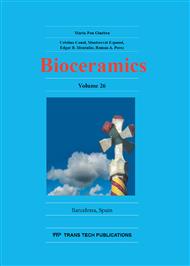p.289
p.295
p.300
p.306
p.315
p.321
p.326
p.332
p.341
pH Effect on the Dissolution Behavior of the Microspheres Containing Strontium Ranelate
Abstract:
Strontium is known for efficient actions on bone formation and resorption. Strontium ranelate (SrR) is a commercial drug which maintains this balance during bone turnover, reducing the risks of vertebral fractures in the patients. Calcium phosphate bioceramics associated with alginate matrices containing strontium (Sr) could improve bone regeneration due to gradual Sr release. In this report, the strontium ranelate was incorporated on microspheres of alginate (ALG)/β-tricalcium phosphate in a single route of the production. Energy dispersive spectroscopy showed that strontium was incorporated on the surface of the microspheres produced. The dissolution behaviour into a buffer solution at pH 4.0 and at 7.4 was evaluated, measuring Sr content on the microspheres after in vitro assays by atomic absorption spectrometry. Dissolution tests showed a rapid strontium release in both assays, however, it was more pronounced at pH 4.0. Fourier transform infrared spectra indicated the presence of a new precipitated phase at pH 7.4 up after 14 days. Scanning electron microscopy of the microspheres submitted to in vitro revealed that the microspheres at pH 4.0 buffer underwent erosion up to 7 days, while the ones in pH 7.4 buffer, eroded in 48h. This behaviour is due to the high swelling rate of the microspheres in neutral pH. The solubility of the microspheres favors its use as a great material for a local strontium release and remodeling bone.
Info:
Periodical:
Pages:
315-320
Citation:
Online since:
November 2014
Keywords:
Price:
Сopyright:
© 2015 Trans Tech Publications Ltd. All Rights Reserved
Share:
Citation:


